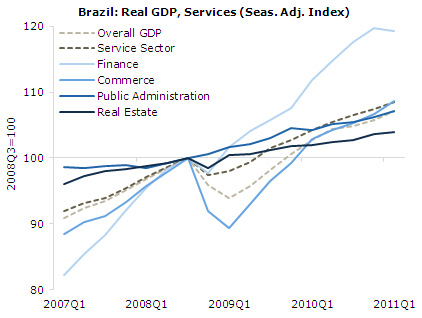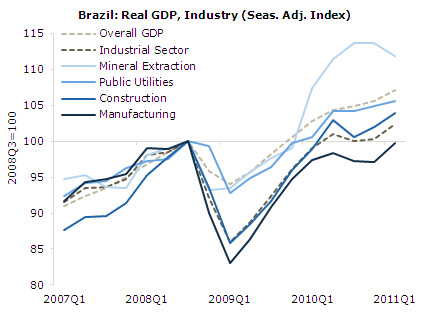A Financeirização da Economia Brasileira: Alguns Dados Recentes, de Tomas Rotta (do Marx21)
A Financeirização da Economia Brasileira: Alguns Dados Recentes

Os setores que mais crescem no Brasil são a extração mineral e as finanças. Já mostramos em um artigo anterior que a economia brasileira está regredindo na cadeia industrial, cada vez mais especializada em produtos de baixo valor agregado. Dados mais recentes mostram que o setor financeiro não pára de crescer. O Brasil do começo do século XXI é o Brasil das finanças, do extrativismo primário e da regressão industrial.
.
No artigo intitulado “Brazil: GDP Continues its Expansion in the First Quarter“, Rebecca Ray mostra que o setor financeiro foi o que mais cresceu no Brasil depois da crise de 2008 nos EUA, seguido pelo setor de extração mineral:
“The two sectors that have had the strongest recovery since the recession, minerals extraction and finance, both lost some ground in the most recent quarter, but both have still far outpaced other sectors since the recession in late 2008. Meanwhile, the sector with the slowest growth since the recession, manufacturing“
“Within the service sector, financial intermediation and insurance has risen at a much faster pace than any other major area. The first quarter of 2011 saw this progress falter for the first time since the recession: it shrank at an annualized rate of 1.6 percent per year, but it is still 19.3 percent above its pre-recession levels. Over the last four quarters, it has grown 6.4 percent, and since the 2008 peak it has grown at an average rate of 7.3 percent per year. This is more than twice the growth in the overall services sector, and GDP as a whole, which have grown at average annual rates of 3.3 and 2.8 percent per year, respectively, since the 2008 peak”
.

.
“Like the service sector, the industrial sector has one area growing much more quickly than the rest: in this case, mineral extraction. It shrank less during the recession (6.8 percent), and for a shorter time (only one quarter), than any other industry. While other industries saw their recovery stagnate in 2010, mineral extraction had three very strong quarters of growth that year, growing at an annualized rate of 38.9, 15.5, and 8.6 percent in each of the first three quarters, respectively. The last quarter of 2010 was essentially flat (it shrank at an annualized rate of 0.2 percent), and the first quarter of 2011 brought a more significant decline (at an annualized rate of 5.9 percent). Nonetheless mineral extraction, currently at 12.0 above its pre-recession peak, has greatly outperformed the rest of the industrial sector, and is the only industry to outperform the economy as a whole”
.

.
“The worst-performing industry has been manufacturing, which finally recovered its pre-recession level in the first quarter of 2011. It lost 16.9 percent of its output during the recession, and like every other industry except mineral extraction, saw its recovery stagnate again in 2010. However, the first quarter of 2011 saw strong growth (11.6 percent annualized), bringing up its growth over the last four quarters to 2.4 percent”
.
Foi por estes motivos acima citados que Mark Weisbrot recentemente declarou que:
“A economia brasileira está crescendo lentamente, no entanto, o governo está reduzindo seus gastos para aumentar o superávit primário, algo que pode desacelerar a economia ainda mais. A produção industrial caiu 1,6% em junho e a atividade econômica caiu pela primeira vez desde 2008. Mas o Brasil tem um problema estrutural que é similar a um dos maiores problemas que temos nos EUA: o setor financeiro é demasiado grande e tem um poder excessivo. Como esse setor não tem muito interesse no crescimento e desenvolvimento – está muito mais obcecado por seus próprios lucros e por minimizar a inflação – seu controle sobre o Banco Central e a política macroeconômica impede o Brasil de realizar seu potencial. [...] A inflação no Brasil está baixa no momento. Nos últimos três meses foi de 4% anual, contra 7% do ano passado. Deixando de lado os interesses mesquinhos do setor financeiro, não existem razões para sacrificar crescimento ou emprego para reduzir a inflação. O setor financeiro é também o maior vilão que está por trás da sobrevalorização do real, que está prejudicando a indústria e o setor manufatureiro brasileiro. [...] Nos últimos quatro anos, o setor financeiro cresceu cerca de 50%, três vezes mais do que o setor industrial” (Mark Weisbrot, O problema “Wall Street” do Brasil)
Fonte: www.marx21.com










.jpg)